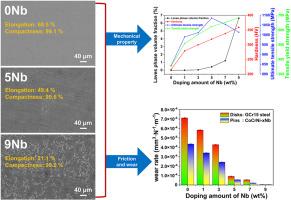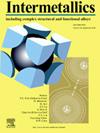Microstructure, mechanical and frictional properties of CrCoNi-xNb alloys prepared through powder metallurgy
IF 4.3
2区 材料科学
Q2 CHEMISTRY, PHYSICAL
引用次数: 0
Abstract
Herein, CoCrNi-xNb (x = 0, 1, 3, 5, 7 and 9 wt%, referred to as 0Nb, 1Nb, 3Nb, 5Nb, 7Nb and 9Nb, respectively) alloys were prepared through mechanical alloying and spark plasma sintering techniques. The impact of Nb on the microstructure, mechanical and frictional properties of CoCrNi medium-entropy alloys were investigated. The evolution of the Laves phase (HCP) structure in alloy systems was well predicted using the (the average energy level of d-orbitals) criterion. The results show that the structure changed from FCC single-phase (x = 0) to FCC + Laves biphase (x > 0). The alloy's hardness, YS and UTS increase as increase of Nb content increases the volume fraction of the Laves phase and reduces the FCC phase. The increase in hardness is beneficial for improving the wear resistance of the material. The wear mechanism of the alloy changes from abrasive to adhesive wear and then to oxidative wear, and it considerably improves the wear resistance of discs and pins. Thus, CoCrNi-xNb/GCr15 steel pairs are expected to achieve excellent tribological properties under high-temperature conditions. Among them, the mechanical and tribological properties of the CoCrNi-5Nb alloy are excellent. These results show that combining plasticity matrix and intermetallic compounds through powder metallurgy is a viable approach for designing high-strength wear-resistant alloys.

通过粉末冶金制备的铬钴镍钴合金的微观结构、机械性能和摩擦性能
本文通过机械合金化和火花等离子烧结技术制备了 CoCrNi-xNb (x = 0、1、3、5、7 和 9 wt%,分别称为 0Nb、1Nb、3Nb、5Nb、7Nb 和 9Nb)合金。研究了 Nb 对 CoCrNi 中熵合金的微观结构、机械性能和摩擦性能的影响。利用Md‾(d-轨道的平均能级)准则很好地预测了合金体系中拉维斯相(HCP)结构的演变。结果表明,合金结构从 FCC 单相(x = 0)转变为 FCC + Laves 双相(x > 0)。随着铌含量的增加,Laves 相的体积分数增加,而 FCC 相的体积分数减少,合金的硬度、YS 和 UTS 也随之增加。硬度的增加有利于提高材料的耐磨性。合金的磨损机理从磨料磨损变为粘着磨损,再变为氧化磨损,从而大大提高了盘和销钉的耐磨性。因此,CoCrNi-xNb/GCr15 钢对有望在高温条件下获得优异的摩擦学性能。其中,CoCrNi-5Nb 合金的机械性能和摩擦学性能都非常出色。这些结果表明,通过粉末冶金结合塑性基体和金属间化合物是设计高强度耐磨合金的可行方法。
本文章由计算机程序翻译,如有差异,请以英文原文为准。
求助全文
约1分钟内获得全文
求助全文
来源期刊

Intermetallics
工程技术-材料科学:综合
CiteScore
7.80
自引率
9.10%
发文量
291
审稿时长
37 days
期刊介绍:
This journal is a platform for publishing innovative research and overviews for advancing our understanding of the structure, property, and functionality of complex metallic alloys, including intermetallics, metallic glasses, and high entropy alloys.
The journal reports the science and engineering of metallic materials in the following aspects:
Theories and experiments which address the relationship between property and structure in all length scales.
Physical modeling and numerical simulations which provide a comprehensive understanding of experimental observations.
Stimulated methodologies to characterize the structure and chemistry of materials that correlate the properties.
Technological applications resulting from the understanding of property-structure relationship in materials.
Novel and cutting-edge results warranting rapid communication.
The journal also publishes special issues on selected topics and overviews by invitation only.
 求助内容:
求助内容: 应助结果提醒方式:
应助结果提醒方式:


